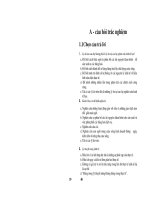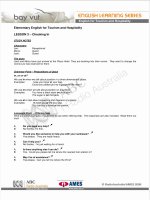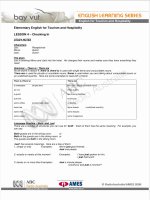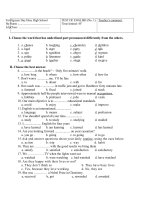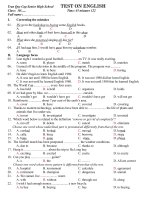BT math4 english
Bạn đang xem bản rút gọn của tài liệu. Xem và tải ngay bản đầy đủ của tài liệu tại đây (234.97 KB, 14 trang )
Hanoi University of Science and Technology
Dr. Bui Xuan Dieu
School of Applied Mathematics and Informatics
Class ICT K62
Math4 Exercises
1
Multiple Integrals
1.1
Double Integrals
1.1.1
Double Integrals in Cartesian coordinate
Exercise 1.1. Evaluate
π
2,0
x sin(x + y)dxdy, where D = (x, y) ∈ R2 : 0 ≤ y ≤
a)
D
≤x≤
π
2
x2 (y − x) dxdy where D is the region bounded by y = x2 and x = y 2 .
b)
D
|x + y|dxdy, D := (x, y) ∈ R2 ||x ≤ 1| , |y| ≤ 1
c)
D
|y − x2 |dxdy, D := (x, y) ∈ R2 ||x| ≤ 1, 0 ≤ y ≤ 1
d)
D
e)
ydxdy
3
2
2 2
[0,1]×[0,1] (1+x +y )
x2
y 2 dxdy,
f)
D
1.1.2
where D is bounded by the lines x = 2, y = x and the hyperbola xy = 1.
Change the order of integration
Exercise 1.2. Change the order of integration
1−x2
1
dx
a)
−1
√
1+
0
0
√
1−y 2
√
f (x, y) dx.
√
y
2
0
2−y
2x
2x−x2
dy
d)
f (x, y) dx.
dy
b)
dx
c)
− 1−x2
1
1.1.3
f (x, y) dy.
√
√
2
2
f (x, y) dx+
0
√
2
Change of variables
4x2 − 2y 2 dxdy, where D :
Exercise 1.3. Evaluate I =
D
1 ≤ xy ≤ 4
x ≤ y ≤ 4x.
Exercise 1.4. Evaluate
x2 sin xy
dxdy,
y
I=
D
where D is bounded by parabolas
x2 = ay, x2 = by, y 2 = px, y 2 = qx, (0 < a < b, 0 < p < q).
1
4−y 2
dy
f (x, y) dx.
0
Exercise 1.5. Evaluate I =
xydxdy, where D is bounded by the curves
D
y = ax3 , y = bx3 , y 2 = px, y 2 = qx, (0 < b < a, 0 < p < q).
Hint: Change of variables u =
x3
y ,v
y2
x .
=
Exercise 1.6. Prove that
1
1−x
0
e−1
.
2
y
dx
e x+y dy =
0
Hint: Change of variables u = x + y, v = y.
Exercise 1.7. Find the area of the domain bounded by xy = 4, xy = 8, xy 3 = 5, xy 3 = 15.
Hint: Change of variables u = xy, v = xy 3 , (S = 2 ln 3).
Exercise 1.8. Find the area of the domain bounded by y 2 = x, y 2 = 8x, x2 = y, x2 = 8y.
Hint: Change of variables u =
y2
x ,v
=
x2
y ,
279π
2 ).
(S =
Exercise 1.9. Hint: Change of variables y = x3 , y = 4x3 , x = y 3 , x = 4y 3 .
Exercise 1.10. Prove that
x−y
x+y
cos
dxdy =
sin 1
.
2
x+y≤1,x≥0,y≥0
Hint: Change of variables u = x − y, v = x + y.
Exercise 1.11. Evaluate
x
+
a
I=
y
b
dxdy,
D
x
a
where D is bounded by the axes and the parabola
1.1.4
+
y
b
= 1.
Double Integrals in polar coordinate
f (x, y) dxdy in terms of polar coordinates, where D
Exercise 1.12. Express the double integral I =
D√
is given by x2 + y 2 ≥ 4x, x2 + y 2 ≤ 8x, y ≥ x, y ≤
3x.
xy 2 dxdym where D is bounded by
Exercise 1.13. Evaluate
x2 + (y − 1)2 = 1
x2 + y 2 − 4y = 0.
D
Exercise 1.14. Evaluate
|x + y|dxdy,
a)
|x − y|dxdy,
b)
D
D
where D : x2 + y 2 ≤ 1.
Exercise 1.15. Evaluate
D
Exercise 1.16. Evaluate
D
4y ≤ x2 + y 2 ≤ 8y
dxdy
,
where
D
:
(x2 +y 2 )2
√
x ≤ y ≤ x 3.
x2 + y 2 ≤ 12, x2 + y 2 ≥ 2x
xy
dxdy,
where
D
:
2
2
x +y
√
x2 + y 2 ≥ 2 3y, x ≥ 0, y ≥ 0.
2
1.2
Applications of Double Integrals
Exercise 1.17. Compute the area of the domain D bounded by
a)
b)
c)
y = 2x , y = 2−x ,
d)
y = 4.
y 2 = x, y 2 = 2x
x2 + y 2 = 2x, x2 + y 2 = 4x
x = y, y = 0.
e) r = 1, r =
f) x2 + y 2
2
√2
3
cos ϕ.
= 2a2 xy (a > 0).
x2 = y, x2 = 2y.
y = 0, y 2 = 4ax
g) x3 + y 3 = axy (a > 0) (Descartes leaf)
x + y = 3a, (a > 0) .
h) r = a (1 + cos ϕ) (a > 0) (Cardioids)
Exercise 1.18. Compute the volume of the object given by
0 ≤ z ≤ 1 − x2 − y 2
b) V :
√
y ≥ x, y ≤ 3x
3x + y ≥ 1, y ≥ 0
a) 3x + 2y ≤ 2,
0 ≤ z ≤ 1 − x − y
c) V :
x2 + y 2 + z 2 ≤ 4a2
x2 + y 2 − 2ay ≤ 0.
Exercise 1.19. Compute the volume of the object bounded by the surfaces
a)
x2
y2
z = 2 + 2 ,z = 0
a
b
b)
2
2
y
2x
x
+ 2 =
2
a
b
a
z = 4 − x 2 − y 2
2z = 2 + x2 + y 2
c)
az = x2 + y 2
z=
x2 + y 2 .
Exercise 1.20. Find the area of the part of the paraboloid x = y 2 + z 2 that satisfies x ≤ 1.
1.3
Triple Integrals
1.3.1
Triple Integrals in Cartesian coordinate
x2 + y 2 dxdydz, where V is bounded by the sphere x2 + y 2 + z 2 = 1 and
Exercise 1.21. Evaluate
V
the cone x2 + y 2 − z 2 = 0.
1.3.2
Change of variables
Exercise 1.22. Evaluate
a)
V
x + y + z = ±3
(x + y + z)dxdydz, where V is bounded by x + 2y − z = ±1 .
x + 4y + z = ±2
(3x2 + 2y + z)dxdydz, where V : |x − y| ≤ 1, |y − z| ≤ 1, |z + x| ≤ 1.
b)
V
dxdydz, where V : |x − y| + |x + 3y| + |x + y + z| ≤ 1.
c)
V
3
1.3.3
Triple Integrals in Cylindrical Coordinates
x2 + y 2 dxdydz, where V :
Exercise 1.23. Evaluate
V
1≤z≤2
x2 + y 2 dxdydz, where:
z
Exercise 1.24. Evaluate
x2 + y 2 ≤ 1
V
a) V is bounded by: x2 + y 2 = 2x and z = 0, z = a (a > 0).
b) V is a half of the sphere x2 + y 2 + z 2 ≤ a2 , z ≥ 0 (a > 0)
x2 + y 2 dxdydz where V is bounded by:
Exercise 1.25. Evaluate I =
V
√
Exercise 1.26. Evaluate
V
1.3.4
x2 + y 2 = z 2
dxdydz
,
x2 +y 2 +(z−2)2
where V :
z = 1.
x2 + y 2 ≤ 1
|z| ≤ 1.
Triple Integrals in Spherical Coordinates
x2 + y 2 + z 2 dxdydz, where V :
Exercise 1.27. Evaluate
V
1 ≤ x2 + y 2 + z 2 ≤ 4
x2 + y 2 ≤ z 2 .
x2 + y 2 + z 2 dxdydz, where V : x2 + y 2 + z 2 ≤ z.
Exercise 1.28. Evaluate
V
x2 + y 2 dxdydz, where V is a half of the ellipsoid
z
Exercise 1.29. Evaluate
V
x2 +y 2
a2
+
z2
b2
≤ 1, z ≥
0, (a, b > 0) .
Exercise 1.30. Evaluate
V
x2
a2
+
y2
b2
+
z2
c2
dxdydz , where V :
x2
a2
+
y2
b2
+
z2
c2
≤ 1, (a, b, c > 0).
z − x2 − y 2 − z 2 dxdydz, where V : x2 + y 2 + z 2 ≤ z.
Exercise 1.31. Evaluate
V
(4z − x2 − y 2 − z 2 )dxdydz, where V is the sphere x2 + y 2 + z 2 ≤ 4z.
Exercise 1.32. Evaluate
V
xzdxdydz, where V is the domain x2 + y 2 + z 2 − 2x − 2y − 2z ≤ −2.
Exercise 1.33. Evaluate
V
Exercise 1.34. Evaluate
dxdydz
,
(1 + x + y + z)3
I=
V
where V is bounded by x = 0, y = 0, z = 0 và x + y + z = 1.
Exercise 1.35. Evaluate
zdxdydz,
V
where V is a half of the ellipsoid
x2
y2
z2
+
+
≤ 1, (z ≥ 0).
a2
b2
a2
Exercise 1.36. Evaluate
a) I1 =
B
x2
a2
+
y2
b2
+
z2
c2
, where B is the ellipsoid
4
x2
a2
+
y2
b2
+
z2
c2
≤ 1.
zdxdydz, where C is the domain bounded by the cone z 2 =
b) I2 =
C
h2
2
R2 (x
+ y 2 ) and the plane
z = h.
z 2 dxdydz, where D is bounded by the sphere x2 +y 2 +z 2 ≤ R2 and the sphere x2 +y 2 +z 2 ≤
c) I3 =
D
2Rz.
(x + y + z)2 dxdydz, where V is bounded by the paraboloid x2 + y 2 ≤ 2az and the sphere
d) I4 =
V
2
x2 + y + z 2 ≤ 3a2 .
Exercise 1.37. Find the volume of the object bounded by the planes 0xy, x = 0, x = a, y = 0, y = b, and
the paraboloid elliptic
z=
y2
x2
+ , (p > 0, q > 0).
2p 2y
Exercise 1.38. Evaluate
x2 + y 2 + z 2 dxdydz,
I=
V
2
2
where V is the domain bounged by x + y + z 2 = z.
Exercise 1.39. Evaluate
I=
zdxdydz,
V
where V is the domain bounded by the surfaces z = x2 + y 2 and x2 + y 2 + z 2 = 6.
Exercise 1.40. Evaluate
xyz
dxdydz,
+ y2
I=
x2
V
where V is the domain bounded by the surface (x2 + y 2 + z 2 )2 = a2 xy and the plane z = 0.
2
Integrals depending on a parameter
2.1
Definite Integrals depending on a parameter
Exercise 2.1. Compute
1+y
a) lim
y→0 y
2
dx
1+x2 +y 2 .
b) lim
y→0 0
x2 cos xydx.
Exercise 2.2. Evaluate
1
a) I (y) =
0
2.2
arctan xy dx.
1
1
ln x2 + y 2 dx.
b) J(y) =
0
0
Improper Integrals depending on a parameter
Exercise 2.3. Show that the integral
∞
a) I(y) =
c) K =
sin(yx)dx is convergent if y = 0 and is divergent if y = 0.
1
5
xb −xa
ln x ,
(0 < a < b).
∞
b) I(y) =
0
1
c) I(y) =
cos αx
x2 +1
is uniformly convergent on R.
x−y dx =
0
+∞
0
∞
0
ty−2 dt is convergent if y < 1 and divergent if y ≥ 1.
1
d) I(y) =
e) I(y) =
∞
e−yx sinx x is uniformly convergent on [0, +∞).
cos αx
x2 +1
is uniformly convergent on R.
+∞
a) Evaluate I(y) =
Exercise 2.4.
ye−yx dx
(y > 0).
0
b) Prove that I(y) converges to 1 uniformly on [y0 , +∞) for all y0 > 0.
c) Explain why I(y) is not uniformly convergent on (0, +∞).
Exercise 2.5. Prove that
∞
a)
2
e−x dx =
0
∞
b)
0
π
2 .
=
g)
0
1
2
cos(x2 )dx =
0
+∞
d)
0
0
∞
∞
0
∞
0
π
2.
sin(x2 )dx =
e)
f)
∞
sin x
x dx
∞
c)
∞
√
π
2.
h)
1−cos yx
x2
x sin yx
a2 +x2 dx
sin yx
x(1+x2 ) dx
+∞
k) lim+
y→0
=
π
2
2
0
π
2 (1
π −ay
,
2e
√
π
√
2 y,
a, y ≥ 0.
y > 0.
√
b
a
√
e− x2 − e− x2 dx = πb − πa, (a, b > 0).
i)
− arctan y.
π
2 |y|.
=
e−yx dx =
+∞
e−yx sinx x =
=
0
− e−y ),
ye−yx dx
0
+∞
y ≥ 0.
x
x
a −arctan b
arctan
j)
x
0
+∞
=
0
dx =
π
2
ln ab ,
(a, b > 0).
lim ye−yx dx and explain why?
y→0+
Exercise 2.6. Evaluate (a, b, α, β > 0):
+∞
a)
0
+∞
b)
0
+∞
c)
0
+∞
d)
0
+∞
e)
0
+∞
f)
+∞
e−αx −e−βx
dx.
x
2
e−αx −e−βx
x2
h)
−∞
2
+∞
dx.
i)
0
+∞
dx
.
(x2 +y)n+1
0
∞
cx
e−ax sin bx−sin
.
x
j)
cx
e−ax cos bx−cos
, (a > 0) .
x
k)
e−ax cos yx.
l)
0
2
e−ax −e−bx
x
3
e−ax −e−bx
x
2
dx,
2
e−ax −cos bx
dx, (a
x2
ln(1 + y cos x)dx,
0
0
∞
2
e−x cos (yx) dx.
m)
0
0
6
2
e−x sin axdx,
sin xy
x dx, y
a, b
dx, where a, b > 0.
0
∞
where
3
π
+∞
g)
arctan(x+y)
dx.
1+x2
≥ 0,
> 0)
>
0.
∞
n)
∞
2
e−ax cos bxdx (a > 0),
p)
0
0
∞
o)
∞
2
x2n e−x cos bxdx, n ∈ N.
q)
0
0
2.3
sin ax cos bx
dx,
x
sin ax sin bx
dx.
x
Euler Integral
Exercise 2.7. Evaluate
π
2
+∞
sin6 x cos4 xdx.
a)
e)
0
0
√
x2n a2 − x2 dx (a > 0) .
a
b)
+∞
f)
0
0
+∞
c)
1
2
x10 e−x dx.
g)
0
0
+∞
d)
0
3
√
h)
0
xn+1
(1+xn ) dx,
1
√
dx,
n
1−xn
+∞
x
dx.
(1+x2 )2
1
1+x3 dx.
(2 < n ∈ N).
n ∈ N∗ .
x4
dx,
(1 + x3 )2
Line Integrals
3.1
Line Integrals of scalar Fields
Exercise 3.1. Evaluate
(x − y) ds, where C is the circle x2 + y 2 = 2x.
a)
C
y 2 ds, where C is the curve
b)
C
x = a (t − sin t)
, 0 ≤ t ≤ 2π, a > 0.
y = a (1 − cos t)
x2 + y 2 ds, where C is the curve
c)
C
x = (cos t + t sin t)
, 0 ≤ t ≤ 2π.
y = (sin t − t cos t)
(x + y)ds, where C is the circle x2 + y 2 = 2y.
d)
C
xyds, where L is the part of the ellipse
e)
L
x2
a2
+
y2
b2
= 1, x ≥ 0, y ≥ 0.
|y|ds, where L is the Cardioid curve r = a(1 + cos ϕ) (a > 0).
f) I =
L
|y|ds, where L is the Lemniscate curve (x2 + y 2 )2 = a2 (x2 − y 2 ).
g) I =
L
3.2
Line Integrals of vector Fields
2 x2 + y 2 dx + x (4y + 3) dy, where ABCA is the quadrangular curve,
Exercise 3.2. Evaluate
ABCA
A(0, 0), B(1, 1), C(0, 2).
Exercise 3.3. Evaluate
ABCDA
dx+dy
|x|+|y| ,
where ABCDA is the triangular curve, A(1, 0), B(0, 1), C(−1, 0), D(0, −1).
7
3.2.1
Green’s Theorem
(xy + x + y) dx + (xy + x − y) dy, where C is the positively ori-
Exercise 3.4. Evaluate the integral
C
ented circle x2 + y 2 = R2 by
i) computing it directly and
ii) Green’s Theorem, then compare the results,
Exercise 3.5. Evaluate the following integrals, where C is a half the circle x2 + y 2 = 2x, traced from
O(0, 0) to A(2, 0).
(xy + x + y) dx + (xy + x − y) dy
a)
C
x2 y +
b)
C
x
4
dy − y 2 x +
y
4
dx.
(xy + ex sin x + x + y) dx − (xy − e−y + x − sin y) dy.
c)
C
ex [(1 − cos y) dx − (y − sin y) dy], where OABO is the triangle, O(0, 0), A(1, 1), B(0, 2).
Exercise 3.6. Evaluate
OABO
3.2.2
Applications of Line Integrals
Exercise 3.7. Find the area of the domain bounded by an arch of the cycloid
x = a(θ − sin θ)
and
y = a(1 − cos θ)
Ox (a > 0).
3.2.3
Independence of Path
(3,0)
x4 + 4xy 3 dx + 6x2 y 2 − 5y 4 dy.
Exercise 3.8. Evaluate
(−2,1)
(2,π)
1−
Exercise 3.9. Evaluate
y2
x2
cos xy dx + sin xy +
y
x
cos xy dy.
(1,π)
4
Surface Integrals
4.1
Surface Integrals of scalar Fields
z + 2x +
Exercise 4.1. Evaluate
S
4y
3
dS, where S = (x, y, z) | x2 +
y
3
+
z
4
= 1, x, y, z ≥ 0 .
x2 + y 2 dS, where S = (x, y, z) |z = x2 + y 2 , 0 ≤ z ≤ 1 .
Exercise 4.2. Evaluate
S
x2 y 2 zdS, where S is the part of the cone z =
Exercise 4.3. Evaluate
x2 + y 2 lies below the plane
S
z = 1.
dS
, where S is the boundary of the triangular pyramid
(2
+
x
+ y + z)2
S
x + y + z ≤ 1, x ≥ 0, y ≥ 0, z ≥ 0.
Exercise 4.4. Evaluate
8
4.2
Surface Integrals of vector Fields
z x2 + y 2 dxdy, where S is a half of the sphere x2 + y 2 + z 2 = 1, z ≥ 0, with
Exercise 4.5. Evaluate
S
the outward normal vector.
2
ydxdz + z 2 dxdy, where S is the surface x2 + y4 + z 2 = 1, x ≥ 0, y ≥ 0, z ≥ 0,
Exercise 4.6. Evaluate
S
and is oriented downward.
x2 y 2 zdxdy, where S is the surface x2 + y 2 + z 2 = R2 , z ≤ 0 and is oriented
Exercise 4.7. Evaluate
S
upward.
4.2.1
The Divergence Theorem
Exercise 4.8. Evaluate the following integrals, where S is the surface x2 + y 2 + z 2 = a2 with outward
orientation.
xdydz + ydzdx + zdxdy
a.
x3 dydz + y 3 dzdx + z 3 dxdy.
b.
S
S
y 2 zdxdy + xzdydz + x2 ydxdz, where S is the boundary of the domain x ≥
Exercise 4.9. Evaluate
S
0, y ≥ 0, x2 + y 2 ≤ 1, 0 ≤ z ≤ x2 + y 2 which is outward oriented.
2
xdydz + ydzdx + zdxdy, where S the boundary of the domain (z − 1) ≤
Exercise 4.10. Evaluate
S
x2 + y 2 , a ≤ z ≤ 1, a > 0 which is outward oriented.
4.2.2
Stokes’ Theorem
F · dr =
Exercise 4.11. Use Stokes’ Theorem to evaluate
C
P dx + Qdy + Rdz. In each case C is
C
oriented counterclockwise as viewed from above.
1. F (x, y, z) = (x + y 2 )i + (y + z 2 )j + (z + x2 )k, C is the triangle with vertices (1, 0, 0), (0, 1, 0) and
(0, 0, 1).
√
2. F (x, y, z) = i + (x + yz)k + (xy − z)k, C is the boundary of the part of the plane 3x + 2y + z = 1
in the first octant.
3. F (x, y, z) = yzi + 2xzj + exy k, C is the circle x2 + y 2 = 16, z = 5.
4. F (x, y, z) = xyi + 2zj + 3yk, C is the curve of intersection of the plane x + z = 5 and the cylinder
y 2 + y 2 = 9.
5
5.1
Vector Calculus
Scalar Fields
Exercise 5.1. Find the directional derivative of the function f (x, y, z) = x2 y 3 z 4 at the point M (1, 1, 1)
in the direction of the vector l = (1, 1, 1).
9
Exercise 5.2. Find
u, where u = r2 +
1
r
x2 + y 2 + z 2 .
+ ln r and r =
Exercise 5.3. In what direction from O(0, 0, 0) does f = x sin z − y cos z have the maximum rate of
change.
5.2
Vector Fields
→
−
→
−
→
−
Exercise 5.4. Let F = xz 2 i + yx2 j + zy 2 k . Find the flux of F across the surface S : x2 + y 2 + z 2 = 1
with the outward direction.
→
−
→
−
→
−
Exercise 5.5. Let F = x(y + z) i + y(z + x) j + z(x + y) k and L is the intersection between the quatity
x2 + y 2 + y = 0 and a half of the sphere x2 + y 2 + z 2 = 2, z ≥ 0. Prove that the circulation of F across L
is equal to 0.
Exercise 5.6. Prove that F is a conservative vector field on Ω if and only if curl F (M ) = 0 ∀M ∈ Ω.
Exercise 5.7. Which of the following fields are conservative and find their potential functions.
−
→
−
→
− →
a. F = 5(x2 − 4xy) i + (3x2 − 2y) j + k .
→
−
→
−
→
−
b. G = yz i + xz j + xy k .
→
−
→
−
→
−
c. H = (x + y) i + (x + z) j + (z + y) k .
6
Series
6.1
Infinite series
∞
Exercise 6.1. Show that the harmonic series
n=1
∞
Exercise 6.2. Find the sum of the series
n=1
1
n
is divergent.
3
n(n+1)
+
1
2n
.
Exercise 6.3. Test for convergence or divergence of the series
∞
a)
n=1
6.1.1
∞
n
sin n+sin
3n+1
b)
n=1
∞
cos n1
c)
n=1
n
n+1
n
.
The Integral Test
∞
Exercise 6.4. Show that the series
n=2
1
n(ln n)p
is convergent iff p > 1.
Exercise 6.5. Test for convergence or divergence of the series
∞
a)
n=1
∞
b)
∞
1
ln n
(n+2)2
n2 e−n
d)
n=1
3
∞
e)
n=1
∞
c)
n=1
n=1
ln n
n3
∞
f)
n=1
∞
ln(1+n)
(n+3)2
g)
e1/n
n2
h)
n2
en
i)
n=1
∞
n=1
∞
n=1
10
∞
ln n
np
j)
ln n
3n2
k)
1
ln(2n+1)
l)
n=2
∞
n=1
∞
n=1
1
ln(2n−1)
√cos n
n3 +1
√sin n .
n3 +1
6.1.2
The Comparison Test
Exercise 6.6. Test for convergence or divergence of the series
∞
1)
n=1
∞
2)
n=1
∞
3)
n=1
∞
4)
n=1
∞
n3
(n+2)4
10)
2016n
2015n +2017n
11)
n sin2 n
1+n3
12)
√
3
√ n
n+3
13)
n=1
∞
∞
n=1
∞
∞
14)
n=1
∞
n=1
∞
7)
n=1
15)
sin n3n+1
+n+1
16)
1
3n2
17)
∞
ln 1 +
8)
n=1
∞
9)
n=1
6.1.3
1 − cos n1
21)
e−1−
n=1
∞
n=1
∞
1
n
22)
n=1
∞
arcsin n2n−1
−n+1
23)
1
[ln(ln(n+1))]ln n
24)
∞
n+sin
n
√
3 7
n +1
∞
20)
√
n
n=2
∞
n=3
arcsin(e−n ),
27)
n=2
∞
1
ln(2n+1)
18)
n=1
∞
n=1
2
nn 2n
(n+1)n2
,
1
, (α, β
nα (ln n)β
3
∞
26)
,
n(ln n) 2
n=1
(−1)n +1
n−ln n ,
n3
n=3
∞
n=1
cos na
(−1)n +2 cos nα
25)
,
(2n−1)!!
3n n! ,
∞
2
1
n en − 1
∞
√
sin(π n2 + a2 ),
n=1
n=1
n=1
6)
19)
− sin n1
1
n
n=1
√
√
sin( n + 1 − n)
∞
5)
∞
√cos n
n3 +1
n=1
na
(1−a2 )n , 0
> 0),
,
< |a| = 1
(n!)2
,
4n2
1
cos n+1
− cos n1 .
Alternating Series
Exercise 6.7. Test for convergence or divergence of the following series
∞
a)
n=1
∞
b)
∞
(−1)n−1
n+1
d)
n=1
2
∞
(−1)n−1 n3n+1 .
e)
2n+1
(−1)n 3n+2n
,
f)
n=1
∞
c)
n=1
∞
n=1
6.1.4
∞
2
(−1)n n3n+4 ,
g)
n=1
∞
(−1)n (n2 +n+1)
,
2n (n+1)
(−1)n sin
n=1
π
n
h)
n=1
∞
i)
,
∞
(−1)n n2
,
πn
j)
(−1)n
3n n! ,
k)
(−1)n
n=1
n=1
∞
n=1
n+1
n+2
1
,
(−1)n sin n√
n
(−1)n lnnn .
n
,
The ratio (d’Alambert) Test
Exercise 6.8. Test for convergence or divergence of the series.
∞
a)
n=1
∞
b)
n=1
6.1.5
∞
2n
n!
c)
2n n!
nn
d)
n=1
∞
n=1
∞
5n (n!)2
n2n
e)
(2n+1)!!
nn
f)
n=1
∞
n=1
The root (Cauchy) Test
Exercise 6.9. Test for convergence or divergence of the series
11
∞
(n2 +n+1)
2n (n+1)
g)
(2n)!!
nn
h)
n=1
22n+1
5n ln(n+1)
∞
ln 1 +
n=1
n+1
2n +1
∞
n2 +n+1
3n2 +n+1
a)
n=1
∞
n
n+2
b)
n=1
n
∞
n
c)
n=1
2
∞
2
nn 5n
∞
n=1
n=1
∞
n(n+4)
n+2
n+3
d)
n+3
n+2
e)
2n (n+1)n2
2n+1
3n+1
f)
n=1
∞
n(n+4)
g)
n=1
∞
n
h)
n=1
√
n2 + n+sin n
2n2 +1
n
n+1
n2
.
Exercise 6.10. Test for convergence or divergence of the series
∞
(a)
n=1
∞
√
(b)
n=2
∞
n=2
∞ √
∞
√1
n
(l)
n=2
∞
n=2
∞
(k)
(g)
(h)
n=1
ln n
√
,
n
n=2
,
(i)
(j)
∞
3
n4
∞
,
1
ln n ,
(f)
,
√
n+1− n−1
n=1
6.1.6
n=1
2
1+n n
n
1
n2
(e)
n
,
(n−1)(n+2)
1+n
n2 −1
(c)
(d)
∞
n
10n2 +1 ,
n=2
∞
n=1
∞
1+n
ln n−1
,
n=2
1
n
− ln 1+n
,
n
2
√
ln nn2+−nn tan n12 ,
(3n+1)!
n2 8n ,
1.3.5...(2n−1)
22n (n−1)! .
Absolute and Conditional Convergence
Exercise 6.11. Test for absolute or conditional convergence of the series
∞
a)
n=1
∞
b)
∞
sin
√ n.
n3
d)
n=1
2n+1
(−1)n 3n+2n
2
∞
e)
n=1
∞
c)
2
(−1)n n3n+4
(−1)n sin
n=1
∞
f)
n=1
n=1
∞
(−1)n (n2 +n+1)
2n (n+1)
n
(−1) n
πn
∞
Exercise 6.12. Prove that the series
n=1
∞
Exercise 6.13. Prove that the series
n=1
g)
n=1
∞
π
n
h)
∞
i)
6.2.1
j)
n=1
n+1
n+2
(−1)n lnnn .
n
1
(−1)n sin n√
n
n=1
sin n
n
is a conditionally convergent.
sin n
np
is
b) conditionally convergent if 0 < p ≤ 1.
a) absolutely convergent if p > 1,
6.2
(−1)n
n=1
2
∞
(−1)n
3n n!
Series of Functions
Domain of convergence
Exercise 6.14. Find the domain of convergence of the series
∞
a)
∞
c)
n=1
n=1
∞
∞
b)
n=1
6.2.2
xn
1
nx
d)
n=1
∞
sin x+cos x
n2 +x2
e)
n=1
∞
xn
n!
f)
n=1
g)
(2n)!! n
nn x
h)
Uniform convergence
Exercise 6.15. Test for uniform convergence of the following series
12
∞
sin nx
2n (n+1)
n=1
∞
n=1
22n+1 xn
5n
x
sin n+sin
3n+1 .
3n
∞
a)
n=1
∞
b)
n=1
(−1)n−1
x2 +n2 , x
sin nx
n2 +x2 , x
∞
∈ R.
c)
n=1
∞
∈ R.
d)
n=1
xn√
,x
2n n 3 n
1
2n−1
∞
Exercise 6.16. Test for continuity of the series of functions
n=1
1
n2
∈ [−2, 2].
2x+1
x+2
n
, x ∈ [−1, 1].
x
.
arctan √n+1
Exercise 6.17. Find the domain of convergence and its sum
∞
a)
∞
(−1)n−1 (n + 1)(x − 1)n
c)
n=1
∞
b)
n=1
∞
(−1)n (2n + 1)x2n
d)
n=1
n=1
(−1)n−1
(x
n
+ 1)n
x2n+1
2n+1 .
Exercise 6.18. Prove that
∞
a) arctan x =
2n+1
(−1)n x2n+1 = x −
n=0
b)
6.3
π
4
∞
=
n=0
x3
3
+
x5
5
2n+1
− · · · + (−1)n x2n+1 + · · · , x ∈ [−1, 1].
(−1)n
2n+1 .
Power Series
Exercise 6.19. Find interval of convergence of the series
∞
a)
∞
2n
x
(−1)n (2n)!
c)
n=0
∞
b)
n=0
n(x+2)
3n+1
n=0
∞
n
d)
n=0
∞
n(x+1)n
4n
n
3 (x+4)
√
n+1
e)
n!(2x − 1)n
n=1
∞
n
f)
n=2
x2n
n(ln n)2
Exercise 6.20. Find a power series representation for
a) f (x) = ln(1 + x)
f) f (x) =
5
1−4x2
k) f (x) = sin2 x
b) f (x) = ln(2 + x)
g) f (x) =
1−x
1+x
l) f (x) = ex sin x
h) f (x) =
2
x2 −x−2
i) f (x) =
x+2
2x2 −x−1
j) f (x) =
x2 +x
(1−x)3
x
c) f (x) =
1
1+x2
d) f (x) = arctan x
m) f (x) =
0
1+x
n) f (x) = ln 1−x
x
e) f (x) =
6.4
2
3−x
2
e−t dt
o) f (x) =
0
sin t
t dt.
Fourier Series
Exercise 6.21. Find the Fourier series of the 2π-periodic function defined as
a) f (x) =
1,
0≤x≤π
−1,
−π ≤ x < 0.
b) f (x) =
13
x,
0≤x≤π
−1,
−π ≤ x < 0.
c) f (x) = x2 , −π < x < π.
d) f (x) =
1,
0≤x≤π
0,
−π ≤ x < 0.
Exercise 6.22. Find the Fourier cosine series and Fourier sine series of the following functions
a) f (x) =
1,
0≤x≤
0,
π
2
π
2
c) f (x) = π + x, 0 ≤ x ≤ π.
.
b) f (x) = 1 − x, 0 ≤ x ≤ π.
d) f (x) = x(π − x), 0 < x < π.
Exercise 6.23. Find the Fourier series of the function f (x) = x2 , −2 ≤ x ≤ 2 which is periodic with
period 2L = 4.
Exercise 6.24. Find the Fourier expansion of
a) f (x) = |x|, |x| < 1
b) f (x) = 2x, 0 < x < 1
14
c) f (x) = 10 − x, 5 < x < 15.
